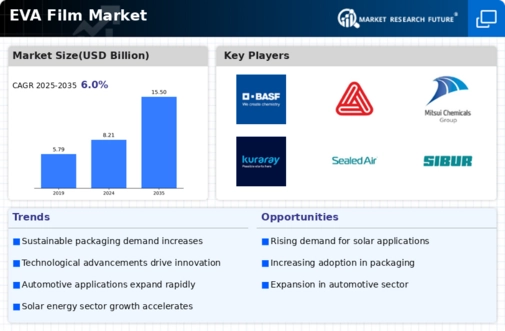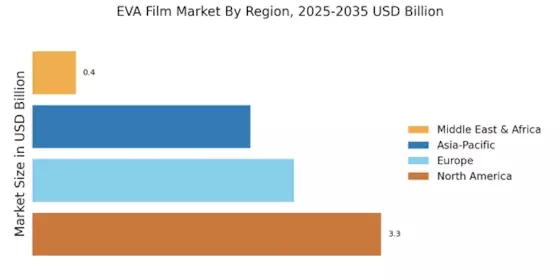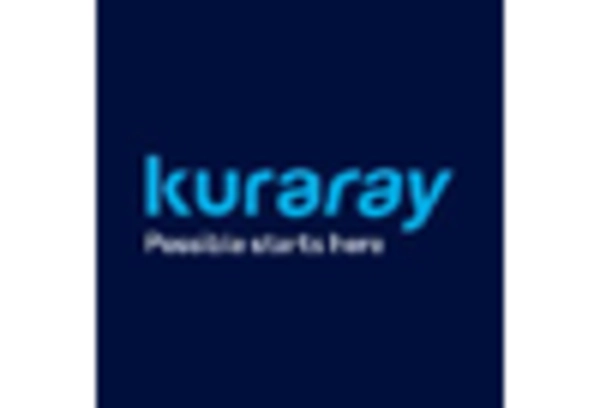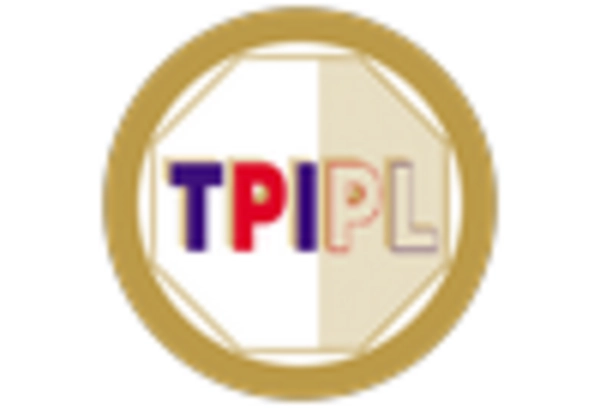Growth in Packaging Industry
The EVA Film Market is significantly influenced by the growth of the packaging industry, which is increasingly leaning towards flexible packaging solutions. EVA films are favored for their excellent sealing properties and ability to provide moisture barriers, making them ideal for food and pharmaceutical packaging. In 2025, the flexible packaging segment is expected to dominate the EVA film market, driven by consumer preferences for convenience and sustainability. The shift towards eco-friendly packaging materials is likely to further enhance the demand for EVA films, as manufacturers seek to reduce their environmental footprint while maintaining product integrity. This trend underscores the importance of the EVA Film Market in supporting sustainable packaging initiatives.
Rising Demand in Automotive Sector
The EVA Film Market is experiencing a notable surge in demand from the automotive sector. As manufacturers increasingly prioritize lightweight materials to enhance fuel efficiency, EVA films are becoming a preferred choice due to their excellent adhesive properties and durability. In 2025, the automotive segment is projected to account for a significant share of the EVA film market, driven by the growing trend of electric vehicles and the need for advanced safety features. The integration of EVA films in automotive applications not only improves performance but also contributes to the overall aesthetic appeal of vehicles. This trend indicates a robust growth trajectory for the EVA Film Market, as automotive manufacturers seek innovative solutions to meet regulatory standards and consumer expectations.
Increasing Focus on Sustainable Materials
The EVA Film Market is increasingly influenced by the global focus on sustainability and eco-friendly materials. As consumers and businesses alike become more environmentally conscious, the demand for sustainable alternatives is rising. EVA films, known for their recyclability and lower environmental impact compared to traditional materials, are gaining traction across various sectors. In 2025, the emphasis on sustainable packaging and construction materials is expected to drive the growth of the EVA film market, as companies seek to align with sustainability goals. This trend not only reflects changing consumer preferences but also indicates a broader shift within industries towards adopting materials that contribute to a circular economy, thereby enhancing the relevance of the EVA Film Market.
Expansion in Renewable Energy Applications
The EVA Film Market is witnessing an expansion in its applications within the renewable energy sector, particularly in solar energy. EVA films are essential in the production of photovoltaic modules, where they serve as encapsulants that protect solar cells from environmental factors. The increasing adoption of solar energy solutions is likely to drive the demand for EVA films, with projections suggesting a compound annual growth rate of over 10% in this segment by 2025. As countries strive to meet renewable energy targets, the EVA Film Market is poised to benefit from this shift towards sustainable energy sources, highlighting the material's critical role in advancing solar technology.
Technological Innovations in Film Production
Technological innovations in the production of EVA films are playing a pivotal role in shaping the EVA Film Market. Advances in manufacturing processes, such as co-extrusion and lamination techniques, are enhancing the performance characteristics of EVA films, making them more versatile for various applications. These innovations are expected to lead to improved product quality and reduced production costs, thereby attracting more manufacturers to the EVA film market. As companies invest in research and development to create high-performance films, the EVA Film Market is likely to witness a surge in new product offerings, catering to diverse industry needs and enhancing competitive dynamics.


















Leave a Comment